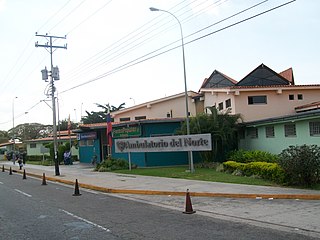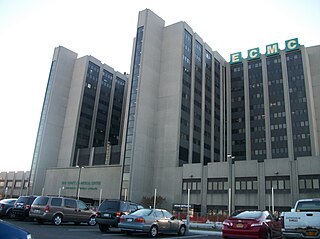| P. Z. Meyer Hospital | |
|---|---|
| Eastern Cape Department of Health | |
| Geography | |
| Location | Humansdorp, Eastern Cape, South Africa |
| Organisation | |
| Care system | Public |
| Hospital type | Specialised |
| Services | |
| Emergency department | Yes |
| Links | |
| Website | P.Z. Meyer Hospital |
| Other links | List of hospitals in South Africa |
P. Z. Meyer Hospital is a Provincial government funded hospital in Humansdorp, Eastern Cape in South Africa.
A government is the system or group of people governing an organized community, often a state.

A hospital is a health care institution providing patient treatment with specialized medical and nursing staff and medical equipment. The best-known type of hospital is the general hospital, which typically has an emergency department to treat urgent health problems ranging from fire and accident victims to a sudden illness. A district hospital typically is the major health care facility in its region, with a large number of beds for intensive care and additional beds for patients who need long-term care. Specialized hospitals include trauma centers, rehabilitation hospitals, children's hospitals, seniors' (geriatric) hospitals, and hospitals for dealing with specific medical needs such as psychiatric treatment and certain disease categories. Specialized hospitals can help reduce health care costs compared to general hospitals. Hospitals are classified as general, specialty, or government depending on the sources of income received.

Humansdorp is a small town and surrounding district in the Eastern Cape of South Africa, with a population of around 29,000 during the census of 2011. It is part of the Kouga Local Municipality of the Sarah Baartman District.
The hospital departments include Occupational Services, Medical Services, Pharmacy, Anti-Retroviral (ARV) treatment for HIV/AIDS, Post Trauma Counseling Services, Out Patients Department, Laundry Services, Kitchen Services.

Pharmacy is the science and technique of preparing, dispensing, and reviewing drugs and providing additional clinical services. It is a health profession that links health sciences with pharmaceutical sciences and aims to ensure the safe, effective, and affordable use of drugs. The professional practice is becoming more clinically oriented as most of the drugs are now manufactured by pharmaceutical industries. Based on the setting, the pharmacy is classified as a community or institutional pharmacy. Providing direct patient care in the community of institutional pharmacies are considered clinical pharmacy.

Human immunodeficiency virus infection and acquired immune deficiency syndrome (HIV/AIDS) is a spectrum of conditions caused by infection with the human immunodeficiency virus (HIV). Following initial infection, a person may not notice any symptoms or may experience a brief period of influenza-like illness. Typically, this is followed by a prolonged period with no symptoms. As the infection progresses, it interferes more with the immune system, increasing the risk of developing common infections such as tuberculosis, as well as other opportunistic infections, and tumors that rarely affect people who have uncompromised immune systems. These late symptoms of infection are referred to as acquired immunodeficiency syndrome (AIDS). This stage is often also associated with unintended weight loss.

Laundry refers to the washing of clothing and other textiles. Laundry processes are often done in a room reserved for that purpose; in an individual home this is referred to as a laundry room, Laundry in Australian English or utility room. An apartment building or student hall of residence may have a shared laundry facility such as a tvättstuga. A stand-alone business is referred to as a self-service laundry. The material that is being washed, or has been laundered, is also generally referred to as laundry.
















